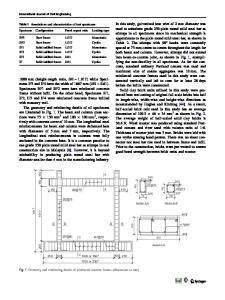Failure mechanisms in SiC-fiber reinforced 6061 aluminum alloy composites under monotonic and cyclic loading
- PDF / 4,680,026 Bytes
- 14 Pages / 597.28 x 785 pts Page_size
- 20 Downloads / 357 Views
I.
INTRODUCTION
CERAMIC-reinforced metal-matrix composites have gained considerable attention in recent years as advanced structural materials for use in many transportation and aerospace applications, t~-6j In comparison to organicmatrix composite materials that are currently used on military airframes, metal-matrix composites o f f e r several advantages, including higher specific strength, stiffness, and abrasive wear resistance, better elevatedtemperature properties, and reduced sensitivity to m o i s t environments. Prominent a m o n g these hybrid systems are high-strength A1, Ti, and Mg alloys reinforced with A1203, SiC, B4C, TiC, and high-modulus materials like B and C, in the form o f particulates, whiskers, o r fibers. Continuous fibers are generally preferred in many applications, because they o f f e r the largest enhancement in properties. These properties are highly directional; f o r example, the specific stiffness and strength o f A1-4 wt pct Mg reinforced with --40 vol pct SiC fibers can be over 2 to 3 times greater in the fiber direction than in the unreinforced matrix materialfl ] However, where such anisotropy is o f concern, multidirectional lay-ups can be produced to yield quasi-isotropic properties. One problem with metal-matrix composites has been that their ductility and toughness are often sharply l o w e r than in unreinforced alloys. ~2-sl Moreover, failure m e c h anisms are generally quite complex and are governed by properties o f the matrix, reinforcement, and the fiber/ matrix interface. Typically, a ductile matrix reinforced K . T . VENKATESWARA RAO, Research Engineer, S.C. SIU, Graduate Student, and R.O. RITCHIE, Professor of Materials Science, are with the Department of Materials Science and Mineral Engineering, University of California, Berkeley, C A 94720. R.O. RITCHIE is also Director, Center for Advanced Materials, Lawrence Berkeley Laboratory, Berkeley, C A 94720. Manuscript submitted February 2 1 , 1992. METALLURGICAL TRANSACTIONS A
with stiff fibers is expected to be tough with a strong interface, whereas w e a k interfaces enhance toughness in composites with high-strength, low-toughness matrices. Limited data available on fracture toughness, mainly for particulate-reinforced composite systems, tT-ml are somewhat conflicting; certain studies indicate a reduction in crack-initiation toughness with an increase in volume fraction and a decrease in spacing o f the reinforcement phase (independent o f particulate size), tg] whereas other studies tim report higher toughness values for coarseparticulate microstructures. With respect to fatigue o f continuous fiber-reinforced metal-matrix composites, damage-mechanics concepts,[lll based on measurements o f reduction in stiffness following stress-life (S-N) fatigue testing, have been successful in modeling the various failure modes and sites o f d a m a g e initiation and accumulation in multiply laminates o f B/6061-A1, SiC/A1, AI2Oa/A1, and SiC/Ti15V-3Cr-3A1-3Sn composites, t12a31 Fatigue d a m a g e is expected to be dominan
Data Loading...











